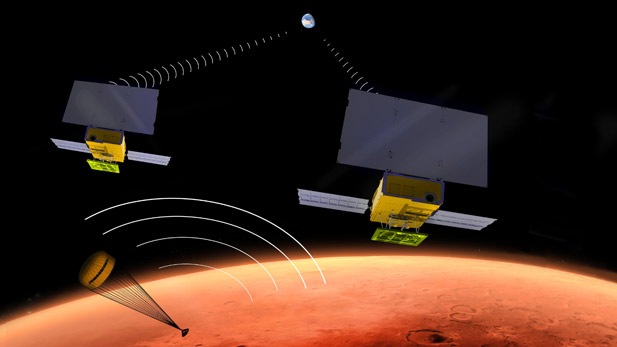Alumnus Sends NASA to Mars to Test New Communication Relay Satellites

NASA’s two MarCO CubeSats are scheduled to fly past Mars in November just as the lander is descending through the Martian atmosphere to the surface, providing an experimental communications relay to quickly inform Earth about the landing. (Image courtesy of NASA/JPL-Caltech)
We’ve all been there: A dark country road late at night with weak or no cell phone coverage. It’s easy to feel cut off from the rest of the world without those signal bars.
Well, deep space was a little like that...but NASA’s MarCO project could soon change things.
MarCO is NASA’s name for Mars Cube One, which refers to two briefcase-sized satellite spacecraft known as “CubeSats.” These tiny spacecraft are designed to tag along behind NASA’s InSight lander on its long journey to Mars, and then beam back information to Earth during InSight's landing. They will also be conducting navigation and communications experiments of their own.
CubeSats are not new, but, in the past, their use has been limited to Earth orbit. The MarCO mission, which launched in May, is historic because it’s the first time CubeSats have faced the intense radiation of deep space or used a propulsion system to find their way to a distant planet.
“Goal number one is to survive deep space,” explains Thomas Werne, an electrical engineering and mathematics alumnus, a NASA technical group supervisor and the flight software lead for the MarCO mission. The second goal is just to arrive successfully at Mars. When you’re traveling nearly 100 million miles from Earth, “it’s awfully difficult to get exactly where you are trying to go,” he says.
The MarCO CubeSats left Earth inside compartments mounted to the Atlas V rocket that carried InSight into space May 5, and were deployed soon after launch to begin their long journey in partnership with one another. The CubeSats are steered using cold gas thrusters commanded from NASA’s Jet Propulsion Laboratory in Pasadena, California, where Werne and his teammates are stationed. While one of the duo spacecraft was reportedly flying perfectly as planned, the other experienced a tiny leak in one of its thruster valves. However, NASA officials were still hopeful it could continue to follow InSight to Mars.
If all goes as planned, InSight, traveling at about 6,200 miles-per-hour, is expected to touch down on Mars shortly after Thanksgiving. The MarCO CubeSats will be close behind, but will not land on the red planet. Rather, they will pass by about 3,000 kilometers above the surface, relaying real-time information back to NASA’s InSight mission team. Even at the speed of light, however, those transmissions will take about 8.7 minutes to reach Earth, meaning NASA scientists will experience several long minutes of uncertainty before knowing whether InSight landed successfully.
NASA is quick to note that success of InSight’s mission, which is to study Martian seismic activity and the planet’s interior, isn’t dependent upon MarCO. That’s because InSight will still be able to send information back to Earth using NASA's Deep Space Network and one of its orbiters already in place around the Red Planet. However, if successful, MarCO could lay the communications groundwork for future deep space missions.
“A big part of MarCO is to prove something like this can be done,” Werne says. “The idea of bringing your own telecommunications relay system with you is something that is potentially very useful.”
The official names of the two CubeSats are MarCO-A and MarCO-B, but to Werne and the team that built them, they're "Wall-E" and "Eva"—nicknames based on Pixar animated movie characters. Both MarCOs use a compressed gas commonly found in fire extinguishers to push themselves through space, the same way Wall-E did in the 2008 eponymous film, according to NASA.
“What’s really cool about this is that we’re providing information about what can be done,” Werne says. “It’s an amazing feeling of accomplishment.”
Werne’s association with NASA took off soon after he met a recruiter from the space agency at a campus career fair. It helped that he had completed two bachelor’s degrees along with a master’s degree in electrical engineering from Rose-Hulman—all within four years and with a perfect 4.0 GPA.